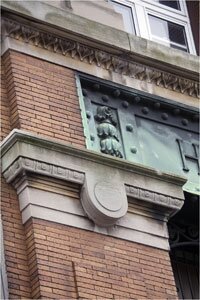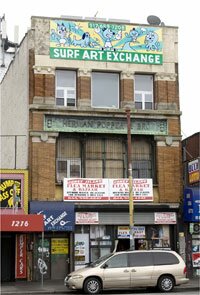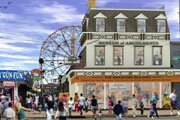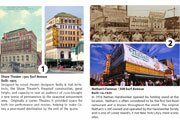Herman Popper Building
Built c. 1904, the Herman Popper building was likely built as a distillery for Popper, a well-known liquor wholesaler in Coney Island. Popper’s business and presence in Coney Island was well-established by the time of the building’s construction. His name appears as early as 1888 in the Brooklyn Daily Eagle as being part of the Coney Island and Gravesend political and business community.
Popper was an associate of John Y. McKane, Coney Island and Gravesend’s notorious political boss, land owner, police chief, and controller of most of Coney Island business in the 1870s and ‘80s. A New York Times article from 1894 states that Popper supplied most of the dives and bars on the Bowery (all controlled by McKane as police chief) with “their inflammatory compounds.” As such, Popper was an integral part of the reputation of the Bowery establishments as rowdy and sinister. Popper testified on McKane’s behalf in the 1893-94 trial in which McKane was eventually convicted of conspiracy with the election inspectors of Gravesend, ending his career.
Popper’s business and place in Coney Island’s business community does not seem to have faltered after the demise of his friend, McKane. In 1895, he’s listed as part of a taxpayer committee that was working to advance the interests of Coney Island. In 1897, the Brooklyn Daily Eagle mentions Popper as an owner of property of Surf Avenue and Henderson’s Walk, the site of the Shore Hotel (not built until c.1903). By 1900, the Eagle lists Popper as owning “nearly all the land,” along with Frederick Henderson of Henderson’s Hall, on Henderson’s Walk between Surf Avenue and the Bowery. The article calls attention to the need for sewers in Coney Island and notes that Popper and Henderson were going to pave Henderson’s Walk, which was privately owned and not a public street, with asphalt rather than with the traditional Coney Island paving of wood planks.
Although a photo of Popper himself has yet to be found, it is know that he was a rather large man, at least in width. He was a proud member of the Fat Men’s Association, a club in which all members were required to weigh at least 200 pounds. As the treasurer of the group, his colleagues joked that he was “too fat to run away with the money.” The Eagle reports that he was 294 pounds in 1890. Little else is known about his personal or family life. An obituary for a Bettie Popper in 1903 lists her son, Herman, as living at 109 Prospect Park West. If this obituary is referring to the same Herman Popper as the Coney Island liquor distributor, he was the child of immigrants from “Hungaria” and may have been born there.
 The Herman Popper building solidified Popper’s presence in Coney Island and even bears the name “Herman Popper & Bro” in the copper piece in the second story entablature. It is not known if Herman Popper’s business was still active when Prohibition took effect in 1920 and if so, whether it continued to operate with reduced visibility. By the 1920s, the building was being used by other businesses. A 1925 photograph of Surf Avenue is taken at too far a distance to determine exactly the businesses operating in the Popper building at that time, but they do not appear to be related to Popper’s liquor business. A Certificate of Occupancy from 1928 lists the ground floor as being occupied by “ordinary uses” and the upper floors vacant. Two 1930s photos show the Popper building as being used as typical small-scale Coney Island business, including Jack’s Games, Steve’s Playland, and a frozen custard place. In 1957, the ground floor was being used by an “electronic pretzel ride,” which is a traditional form of an amusement park dark ride.
The Herman Popper building solidified Popper’s presence in Coney Island and even bears the name “Herman Popper & Bro” in the copper piece in the second story entablature. It is not known if Herman Popper’s business was still active when Prohibition took effect in 1920 and if so, whether it continued to operate with reduced visibility. By the 1920s, the building was being used by other businesses. A 1925 photograph of Surf Avenue is taken at too far a distance to determine exactly the businesses operating in the Popper building at that time, but they do not appear to be related to Popper’s liquor business. A Certificate of Occupancy from 1928 lists the ground floor as being occupied by “ordinary uses” and the upper floors vacant. Two 1930s photos show the Popper building as being used as typical small-scale Coney Island business, including Jack’s Games, Steve’s Playland, and a frozen custard place. In 1957, the ground floor was being used by an “electronic pretzel ride,” which is a traditional form of an amusement park dark ride.
Today, the Herman Popper building is still standing in Coney Island, although its façade has been altered somewhat. Its original materials and Classical details, like the orange Roman bricks, stone trim, copper “Herman Popper & Bro” entablature, and second-story window ironwork are extant, although its cornice has been removed. The building is currently used as Flea Market and the Surf Avenue Art Exchange.



